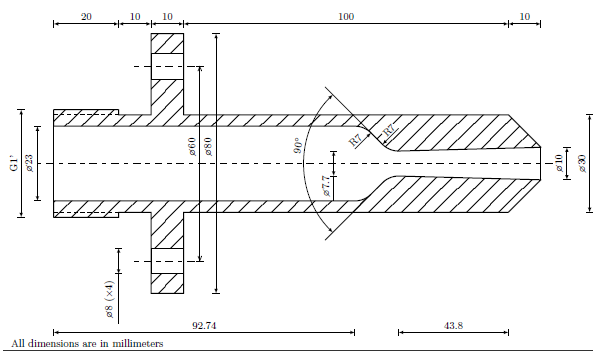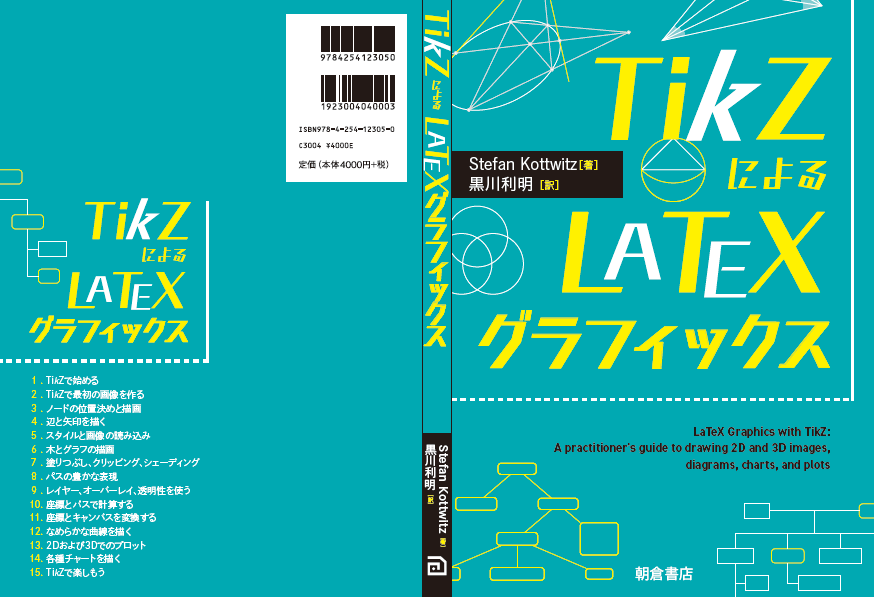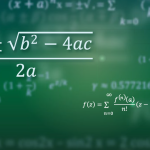This is a cold air supersonic nozzle I used for my master thesis. The super sonic flow is reachable with a total upstream pressure of 7.7bar.

Edit and compile if you like:
% Supersonic technical drawing
% Author: Michele Muccioli
\documentclass{standalone}
\usepackage{tikz}
\usetikzlibrary{calc,patterns,arrows,shapes.arrows,intersections}
\usetikzlibrary{decorations}
\usepackage{wasysym}
\usepackage{siunitx}
%%%%%%%%%%%%%%%%%%%%%%%%%%%%%%
% SECTION PATTERN DEFINITION %
%%%%%%%%%%%%%%%%%%%%%%%%%%%%%%
\newlength\thickness
\pgfdeclarepatternformonly[\thickness]{section}
{\pgfpointorigin}
{\pgfpoint{1cm}{1cm}}
{\pgfpoint{1cm}{1cm}}
{
\pgfsetlinewidth{\thickness}
\pgfpathmoveto{\pgfpoint{0cm}{0cm}}
\pgfpathlineto{\pgfpoint{1cm}{1cm}}
\pgfpathclose
\pgfsetlinewidth{\thickness}
\pgfpathmoveto{\pgfpoint{0cm}{.5cm}}
\pgfpathlineto{\pgfpoint{.5cm}{1cm}}
\pgfpathclose
\pgfsetlinewidth{\thickness}
\pgfpathmoveto{\pgfpoint{.5cm}{0cm}}
\pgfpathlineto{\pgfpoint{1cm}{.5cm}}
\pgfusepath{stroke}
}
\tikzset{
thickness/.store in = \thickness,
thickness = 0.5pt
}
%%%%%%%%%%%%%%%%%%%%%%%%%
% DIMENSION DECORATIONS %
%%%%%%%%%%%%%%%%%%%%%%%%%
\makeatletter
%-> New if
\newif\if@dim@connection
%-> New TeX dimensions
\newdimen\dim@x
\newdimen\dim@y
\newdimen\dim@sep
\newdimen\dim@overline
\newdimen\dim@overlineI
\newdimen\dim@overlineII
\newdimen\dim@text@translation
% x=, y=
%\newif\iftikz@isdimension
%\def\tikz@checkunit#1{%
% \pgfmathparse{#1}%
% \let\iftikz@isdimension=\ifpgfmathunitsdeclared%
%}
%\tikz@checkunit{1}
%\iftikz@isdimension
%true
%\else
%false
%\fi
% output scale
% \pgf@pt@x=\pgf@x%
% \pgf@pt@y=\pgf@y%
% \let\pgf@pt@aa=\pgf@tempaa%
% \let\pgf@pt@ba=\pgf@tempba%
% \let\pgf@pt@ab=\pgf@tempab%
% \let\pgf@pt@bb=\pgf@tempbb%
% \def\pgf@trans@idtest{#1,#2,#3,#4}%
% \ifx\pgf@trans@idtest\pgf@trans@idtext%
% \else%
% \pgf@pt@identityfalse%->\ifpgf@pt@identity
% \fi%
%-> Horizontal dimension
\pgfdeclaredecoration{Hdim}{final}{%
\state{final}{%
% Setting needed dimensions from pgfkeys values.
\tikz@checkunit{\pgfkeysvalueof{/pgf/decoration/distance}}
\iftikz@isdimension
\pgfmathsetlength{\dim@sep}{\pgfkeysvalueof{/pgf/decoration/distance}}
\else
\pgfmathsetlength{\dim@sep}{\pgfkeysvalueof{/pgf/decoration/distance}*\pgf@yy}
\fi
\pgfmathsetlength{\dim@x}{\pgfdecoratedpathlength*cos(\pgfdecoratedangle)}
\pgfmathsetlength{\dim@y}{\pgfdecoratedpathlength*sin(\pgfdecoratedangle)}
\pgfmathsetlength{\dim@overline}{\pgfkeysvalueof{/pgf/decoration/overline}}
\pgfmathsetlength{\dim@text@translation}{\pgfkeysvalueof{/pgf/decoration/text translation}}
% Setting text to write from pgfkeys value.
\def\dim@text{\pgfkeysvalueof{/pgf/decoration/text}}
% The overline verse (where it points. Positive or negative) depends
% on dimension sep and angle of the segment to dimension.
\ifdim0pt<\dim@sep
% Case with positive dimension sep.
% Normal behaviour.
\pgfmathsetlength{\dim@overlineI}{\dim@overline}
\pgfmathsetlength{\dim@overlineII}{\dim@overline}
\else
% Case with negative dimension sep.
% The value of dimension overline I is different from
% dimension overline II and it depends on the
% quadrant where the the segment is.
\pgfmathparse{abs(\dim@sep) Vertical dimension (NOT UTILISED IN THE FOLLOWING DRAWING)
\pgfdeclaredecoration{Vdim}{final}{%
\state{final}{%
% Setting needed dimensions from pgfkeys values.
\tikz@checkunit{\pgfkeysvalueof{/pgf/decoration/distance}}
\iftikz@isdimension
\pgfmathsetlength{\dim@sep}{\pgfkeysvalueof{/pgf/decoration/distance}}
\else
\pgfmathsetlength{\dim@sep}{\pgfkeysvalueof{/pgf/decoration/distance}*\pgf@yy}
\fi
\pgfmathsetlength{\dim@x}{\pgfdecoratedpathlength*cos(\pgfdecoratedangle)}
\pgfmathsetlength{\dim@y}{\pgfdecoratedpathlength*sin(\pgfdecoratedangle)}
\pgfmathsetlength{\dim@overline}{\pgfkeysvalueof{/pgf/decoration/overline}}
\pgfmathsetlength{\dim@text@translation}{\pgfkeysvalueof{/pgf/decoration/text translation}}
% Setting text to write from pgfkeys value.
\def\dim@text{\pgfkeysvalueof{/pgf/decoration/text}}
% The overline verse (where it points. Positive or negative) depends
% on dimension sep and angle of the segment to dimension.
\ifdim0pt<\dim@sep
% Case with positive dimension sep.
% Normal behaviour.
\pgfmathsetlength{\dim@overlineI}{\dim@overline}
\pgfmathsetlength{\dim@overlineII}{\dim@overline}
\else
% Case with negative dimension sep.
% The value of dimension overline I is different from
% dimension overline II and it depends on the
% quadrant where the the segment is.
\pgfmathparse{abs(\dim@sep)\pgfdecoratedangle
% Third quadrant
% Node drawing. It can be translate along the path with
% text translation option.
{
\pgftransformshift{\pgfpoint{\dim@sep}{\dim@y/2-\dim@text@translation}}
% In this case, the node must e rotated.
\pgftransformrotate{-90}
% Capturing the TikZ picture font size
\dim@text@font
\pgfnode{rectangle}{south}{\dim@text}{\dim@text@nodename}{\pgfusepath{discard}}
}
% Drawing the connection segments.
\pgfpathmoveto{\pgfpoint{\dim@sep+\dim@overlineI}{0pt}}
% Check if the first connection line must be drawn.
\if@dim@connection
\pgfpathlineto{\pgfpoint{0pt}{0pt}}
\else
\pgfpathlineto{\pgfpoint{\dim@sep-\dim@overlineI}{0pt}}
\fi
\pgfpathmoveto{\pgfpoint{\dim@sep+\dim@overlineII}{\dim@y}}
% Check if the second connection line must be drawn.
\if@dim@connection
\pgfpathlineto{\pgfpoint{\dim@x}{\dim@y}}
\else
\pgfpathlineto{\pgfpoint{\dim@sep-\dim@overlineII}{\dim@y}}
\fi
% Draw an extra line if node text lies outside of the
% dimension.
\pgfmathparse{abs(.5\dim@y)\pgfdecoratedangle
% First quadrant
% Node drawing. It can be translate along the path with
% text translation option.
{
\pgftransformshift{\pgfpoint{\dim@x+\dim@sep}{\dim@y/2-\dim@text@translation}}
% In this case, the node must e rotated.
\pgftransformrotate{-90}
% Capturing the TikZ picture font size
\dim@text@font
\pgfnode{rectangle}{south}{\dim@text}{\dim@text@nodename}{\pgfusepath{discard}}
}
% Drawing the connection segments.
\pgfpathmoveto{\pgfpoint{\dim@x+\dim@sep+\dim@overlineI}{0pt}}
% Check if the first dimension connection must be drawn.
\if@dim@connection
\pgfpathlineto{\pgfpoint{0pt}{0pt}}
\else
\pgfpathlineto{\pgfpoint{\dim@x+\dim@sep-\dim@overlineI}{0pt}}
\fi
\pgfpathmoveto{\pgfpoint{\dim@x+\dim@sep+\dim@overlineII}{\dim@y}}
% Check if the second dimension connection must be drawn.
\if@dim@connection
\pgfpathlineto{\pgfpoint{\dim@x}{\dim@y}}
\else
\pgfpathlineto{\pgfpoint{\dim@x+\dim@sep-\dim@overlineII}{\dim@y}}
\fi
% Draw an extra line if node text lies outside of the
% dimension.
\pgfmathparse{abs(.5\dim@y) Along the dimension
\pgfdeclaredecoration{dim}{final}{
\state{final}{%
% Check if the dimension inserted has unit
\tikz@checkunit{\pgfkeysvalueof{/pgf/decoration/distance}}
\iftikz@isdimension
\pgfmathsetlength{\dim@sep}{\pgfkeysvalueof{/pgf/decoration/distance}}
\else
\pgfmathsetlength{\dim@sep}{\pgfkeysvalueof{/pgf/decoration/distance}*\pgf@yy}
\fi
% Overline value if function of the sep sign.
\ifdim0pt>\dim@sep
\pgfmathsetlength{\dim@overline}{-\pgfkeysvalueof{/pgf/decoration/overline}}
\else
\pgfmathsetlength{\dim@overline}{\pgfkeysvalueof{/pgf/decoration/overline}}
\fi
\pgfmathsetlength{\dim@text@translation}{\pgfkeysvalueof{/pgf/decoration/text translation}}
% Setting the text to be inserted into the dimension node.
\def\dim@text{\pgfkeysvalueof{/pgf/decoration/text}}
{
\pgftransformshift{\pgfpoint{\pgfdecoratedpathlength/2+\dim@text@translation}{\dim@sep}}
% Capturing the TikZ picture font size
\dim@text@font
\pgfnode{rectangle}{south}{\dim@text}{\dim@text@nodename}{\pgfusepath{discard}}
}
\pgfpathmoveto{\pgfpoint{0pt}{\dim@sep+\dim@overline}}
% Check if the first connection line mus b drawn
\if@dim@connection
\pgfpathlineto{\pgfpoint{0pt}{0pt}}
\else
\pgfpathlineto{\pgfpoint{0pt}{\dim@sep-\dim@overline}}
\fi
\pgfpathmoveto{\pgfpoint{(\pgfdecoratedpathlength}{\dim@sep+\dim@overline}}
% Check if the first connection line mus b drawn
\if@dim@connection
\pgfpathlineto{\pgfpoint{\pgfdecoratedpathlength}{0pt}}
\else
\pgfpathlineto{\pgfpoint{(\pgfdecoratedpathlength}{\dim@sep-\dim@overline}}
\fi
% Draw an extra line if node text lies outside of the
% dimension.
\pgfmathparse{abs(.5*\pgfdecoratedpathlength) Initial values
\pgfkeys{/pgf/decoration/.cd,
distance/.initial = 10pt,
overline/.initial = 1mm,
text/.initial = {},
text translation/.initial = 0pt,
text node name/.store in = \dim@text@nodename,
text node name = dim_text,
>/.store in = \dim@arrow@type,
> = latex,
connection/.is if = @dim@connection,
connection = false,
font/.store in = \dim@text@font,
font = \tikz@textfont,
}
\makeatother
%%%%%%%%%%%%%%%%%%%%%%%%%%%%%%%%%%%%%%%%%%
% COMMANDS TO CALL DIMENSION DECORATIONS %
%%%%%%%%%%%%%%%%%%%%%%%%%%%%%%%%%%%%%%%%%%
\newcommand\Hdimension[1][]{\path[decorate,decoration={Hdim,#1}]}
\newcommand\Vdimension[1][]{\path[decorate,decoration={Vdim,#1}]}
\newcommand\dimension[1][]{\path[decorate,decoration={dim,#1}]}
\begin{document}
\begin{tikzpicture}[x = 1mm,
y = 1mm,
> = latex,
line join = round,
font = \small]
%%%%%%%%%%%%%%%%%%
% NOZZLE DRAWING %
%%%%%%%%%%%%%%%%%%
%-> Origin definition
\coordinate (o) at (0,0);
%-> Nozzle
% Symmetric characteristic is used in a
% foreach command where the cycle is made
% for upper part (up) with positive sign (+)
% and lower part (down) with negative sign (-)
\foreach \pos/\sign in {up/+,down/-}{
%%-> Points definitions
\coordinate (A\pos) at ($(o)+(0,\sign11.5)$);
\coordinate (B\pos) at ($(A\pos)+(0,\sign5.075)$);
\coordinate (C\pos) at ($(B\pos)+(20,0)$);
\coordinate (D\pos) at ($(C\pos)+(0,-\sign1.575)$);
\coordinate (E\pos) at ($(D\pos)+(10,0)$);
\coordinate (F\pos) at ($(E\pos)+(0,\sign11)$);
\coordinate (G\pos) at ($(F\pos)+(0,\sign8)$);
\coordinate (H\pos) at ($(G\pos)+(0,\sign6)$);
\coordinate (I\pos) at ($(H\pos)+(10,0)$);
\coordinate (L\pos) at (G\pos-|I\pos);
\coordinate (M\pos) at (F\pos-|I\pos);
\coordinate (N\pos) at (E\pos-|I\pos);
\coordinate (O\pos) at ($(N\pos)+(100,0)$);
\coordinate (P\pos) at ($(O\pos)+(10,-\sign10)$);
\coordinate (throat_\pos) at ($(P\pos)-(43.8,\sign1.15)$);
\coordinate (IN_\pos) at ($(A\pos)+(92.74,0)$);
\coordinate (center1_\pos) at ($(o)+(92.74,\sign4.5)$);
\coordinate (center2_\pos) at ($(throat_\pos)+(0,\sign7)$);
%%-> Draw nozzle main body
\draw[fill,
pattern = section,
line width = 1.1pt]
\ifnum\sign1>0
(center1_\pos)++(45:7)arc(45:90:7)--
\else
(center1_\pos)++(-45:7)arc(315:270:7)--
\fi
(A\pos)--
(B\pos)--
(C\pos)--
(D\pos)--
(E\pos)--
(F\pos)--
(G\pos)--
(H\pos)--
(I\pos)--
(L\pos)--
(M\pos)--
(N\pos)--
(O\pos)--
(P\pos)--
(throat_\pos)
\ifnum\sign1>0
arc(270:225:7)
\else
arc(90:135:7)
\fi
--cycle;
%%-> Draw holes on the flange
\draw[fill = white,
line width = 1.1pt] (G\pos)rectangle(M\pos);
%%-> Draw symmetric axis on flange holes
\draw[dash pattern = on 3pt off 5pt on 6pt off 5pt,
line width = 1pt] ($(F\pos)!.5!(G\pos)-(5,0)$)--
($(L\pos)!.5!(M\pos)+(5,0)$);
%%-> screw drawing
\draw[dashed] (D\pos)--(D\pos-|A\pos);
}
%%-> Nozzle input and output closure
\draw[line width = 1.1pt](Adown)--(Aup)
(Pdown)--(Pup);
%%-> Nozzle symmetry line
\draw[dash pattern = on 3pt off 5pt on 6pt off 5pt,
line width = 1pt] ($(Adown)!.5!(Aup)-(5,0)$)--($(Pdown)!.5!(Pup)+(5,0)$);
%%%%%%%%%%%%%%
% DIMENSIONS %
%%%%%%%%%%%%%%
% Macro to see the dimension
% inserted. For debug.
\newif\ifdimension
\dimensionfalse
%\dimensiontrue % if true, you will see the dimension number (%x) on the draw
\newcount\Ndim=0
\def\SeeDim#1{\ifdimension\global\advance\Ndim by 1 \the\Ndim\else#1\fi}
%-> 1
\Hdimension[text = \SeeDim{10},
distance = 3] (Hup) -- (Iup);
%-> 2
\Hdimension[text = \SeeDim{10},
distance = 3] (Cup)--(Hup);
%-> 3
\Hdimension[text = \SeeDim{20},
distance = 26.425] (Bup)--(Cup);
%-> 4
\Hdimension[text = \SeeDim{100},
distance = 3] (Iup)--(Oup);
%-> 5
\Hdimension[text = \SeeDim{10},
distance = 28] (Oup)--(Pup);
%-> 6
\dimension[text = \SeeDim{\diameter30},
distance = -25] (Odown)--(Oup);
%-> 7
\Hdimension[text = \SeeDim{43.8},
distance = -48.15] (throat_down)--(Odown);
%-> 8
\Hdimension[text = \SeeDim{92.74},
distance = -40.5] (IN_down)--(Bdown);
%-> 9
\dimension[text = \SeeDim{\diameter7.7},
text translation = -7mm,
distance = 20] (throat_down)--(throat_up);
%-> 10
\dimension[text = \SeeDim{\diameter10},
distance = -8] (Pdown)--(Pup);
%-> 11 (by hand)
\draw[->] (center1_up)--++(45:7)node[sloped,
above = .4mm,
pos = .3,
inner sep = 0.5pt]{\SeeDim{R7}};
%-> 12 (by hand)
\draw[->] (center2_up)--++(225:7)node[above = .4mm,
pos = .4,
inner sep = 0.5pt,
rotate = 45,
fill = white]{\SeeDim{R7}};
%-> 13 (by hand)
\coordinate (raccordo_up) at ($(center1_up)+(45:7)$);
\coordinate (raccordo_down) at ($(center1_down)+(-45:7)$);
\draw (raccordo_up)--++(135:20);
\draw (raccordo_down)--++(225:20);
\path[name path=C1](raccordo_up)--++(-45:20);
\path[name path=C2](raccordo_down)--++(45:20);
\path[name intersections={of=C1 and C2}];
\coordinate (C90) at (intersection-1);
\draw[<->] ($(C90)+(135:30)$)arc[start angle = 135,
delta angle = 90,
radius = 30];
\def\angle{35}
\node[rotate = \angle+45,
anchor = south] at ($(C90)+(135+\angle:30)$){\SeeDim{\ang{90}}};
%-> 14
\dimension[text = \SeeDim{\diameter60},
distance = -5,
> = angle 45,
text translation = .5cm] ($(Ldown)!.5!(Mdown)$)--($(Lup)!.5!(Mup)$);
%-> 15
\dimension[text = \SeeDim{\diameter80},
distance = -10,
text translation = .5cm] (Idown)--(Iup);
%-> 16
\dimension[text = \SeeDim{\diameter8 ($\times$4)},
distance = 10,
text translation = -12mm] (Gdown)--(Fdown);
%-> 17
\dimension[text = \SeeDim{G1'},
distance = 10] (Bdown)--(Bup);
%-> 18
\dimension[text = \SeeDim{\diameter23},
distance = 5] (Adown)--(Aup);
% Dimensions scale
\node[anchor = north west] at (current bounding box.south west)
{All dimensions are in millimeters};
\end{tikzpicture}
\end{document}
Click to download: supersonic-nozzle.tex • supersonic-nozzle.pdf
Open in Overleaf: supersonic-nozzle.tex

